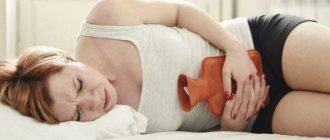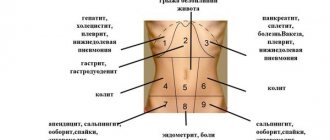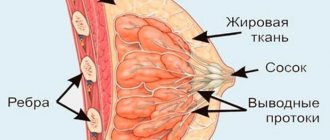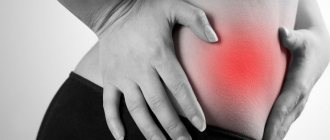Sometimes it happens that the pain syndrome spreads directly to the chest and lower back. Any pain has its own reasons for its occurrence. Due to the fact that the pain is located in the chest area, a person often experiences hypochondria. A person begins to worry and worry greatly that he has developed diseases with the cardiovascular system. But it is important to remember that the causes of pain can be very different, you should not get upset and scared ahead of time, you should first undergo a comprehensive examination with a doctor and determine why your mammary glands hurt before your period.
Cause of lower back pain before and during menstruation
The reasons why the lower back hurts before menstruation can be divided into 2 types. The first may be associated with the onset of menstrual periods and are caused by changes in the production of female sex hormones, which is the norm. The latter indicate health problems.
Natural causes of pain in the lumbar region during this period:
- Features of the female body and the specific location of the genital organs, in particular the curvature of the cervix. Before menstruation, the uterus increases in size, pressing on the nerve receptors of neighboring organs, which provokes pain in the lumbar region.
- Contractions of the uterus. The insertion of an intrauterine device increases the pain.
- Low pain threshold and increased sensitivity to pain.
- Increased amount of estrogen released. It affects not only the contraction of the uterus, but also the body’s ability to secrete substances that dull pain.
- Genetic predisposition. If relatives of older generations experienced painful sensations before menstruation, then the girl will most likely inherit this feature.
- Fluid retention and swelling typical before menstruation. May cause discomfort and pain in the spine due to internal pressure.
This symptom appears a week before menstruation and goes away a couple of days after it starts.
Among the causes of back pain not associated with the onset of menstruation, the most common are pathological conditions of the endocrine system and genital organs, as well as pregnancy.
Read more about them below.
Diseases of the cardiovascular system
Breast pain a week before menstruation (and not only) and due to the following diseases in the body:
- The most common disease is angina pectoris. A burning sensation and pain spreads through the center of the chest and also radiates to the lumbar spine
- Myocardial infarction is a fairly common disease that causes severe pain in the arms, lower back and back. The vessels are severely compressed due to the formation of blood clots. In this case, it is important to go to see a doctor and conduct a comprehensive diagnosis.
- Another common cause of pain is myocarditis. In addition to pain, the woman experiences weakness throughout her body, problems with the respiratory system, and fatigue. Severe aching pain spreads in the chest.
- Pericarditis, which is dangerous due to severe chest pain on the left. As a result, a strong inflammatory process of the mucous membrane of the heart begins, and the body temperature rises greatly.
- The most dangerous cause of chest and lower back pain is an aortic aneurysm. Additional symptoms include numbness of the limbs, acute pain, and paralysis.
What symptoms can there be during normal periods?
Back pain before menstruation is not the only sensation during the premenstrual period that is considered normal. It is of a pulling and aching nature and covers a significant area of the body: the lower back may hurt, as well as the entire area of the pelvic organs, in particular pain in the lower abdomen appears.
The following symptoms may also occur:
- unpleasant sensations - pulling in the lower abdomen. In conditions of changing hormonal levels, the uterus contracts, which leads to pain;
- increased sensitivity and heaviness in the chest;
- nervousness, sudden mood swings, irritability;
- increased appetite, the emergence of specific taste preferences;
- headaches, dizziness, drowsiness;
- weight gain from 1 to 3 kg, caused by stagnation of excess fluid and an increase in the muscle mass of the uterus. The pressure of the internal organs on each other during swelling also causes pain in the tailbone.
What affects the intensity of pain?
Pain is a sign of suffering in the body; it cannot be the norm. In all women, during the period of ovulation, estrogen is rampant, fluid is retained in the body, why do some women have intense breast pain, while for others the period of ovulation and menstruation goes unnoticed.
Individual sensitivity depends on:
- on health status;
- pain threshold;
- obesity/excessive thinness;
- lifestyle (heavy loads or physical inactivity, lack of sleep or stress);
- harmony and regularity of sexual life;
- excessive addiction to fun drinks (alcohol), smoking, coffee;
- from the environment and working conditions;
- from the presence of recent hormonal disturbances associated with medical or self-abortion, fading pregnancy;
- age.
The more negative factors present in your life, the higher the risk of severe pain in the premenstrual period.
Pathological conditions causing back pain
If your lower back hurts severely before menstruation, this may indicate the presence of pathological processes, such as:
- Infectious diseases of the reproductive and excretory systems. In addition to pain, the woman experiences a frequent urge to empty the bladder, accompanied by discomfort and burning.
- Benign formations, cysts on the organs of the genitourinary system. These are indicated by discharge with bloody mucus, tingling in the uterus, increased sensitivity of the mammary glands and disruptions of the menstrual cycle.
- Disorders of the endocrine system, causing hormonal imbalance. In addition to lower back pain, the disease is accompanied by weight loss, nausea, swelling in the legs and a general deterioration in well-being.
In these cases, the pain that occurs is acute and severe. Additional symptoms of pathological conditions:
- odor aversion;
- increased fatigue;
- sleep disturbance;
- absent-mindedness.
The woman urgently needs to consult a specialist and undergo an examination to confirm the diagnosis.
The lower back can feel tight before menstruation and in the early stages of pregnancy, both uterine and ectopic. The hCG detection procedure will help determine it before the delay.
How to get rid of back pain
The following actions will help reduce pain before menstruation:
- Preventive and health-improving massage of the back and abdominal muscles, which will help keep the spine healthy and muscles toned.
- A healthy balanced diet to prevent the accumulation of toxins in the intestines and increased gas formation. The increased volume of the digestive organs increases internal pressure. Some experts recommend minimizing coffee consumption, and in the days before menstruation, giving it up completely.
- A relaxing bath with herbs and essential oils that can be taken before or after the onset of discomfort.
- Use vitamin complexes as prescribed by a doctor.
- Regular physical activity will not only strengthen your back muscles, but also improve your overall immunity.
- Exercises to reduce pain: breathing exercises, yoga asanas, stretching. Effective when the symptom has already appeared. Self-massage of the lower abdomen and lower back using circular movements of medium intensity will also help.
- Treatment of pathologies that cause pain.
- Hormonal support of the body. Most often, it is carried out by taking contraceptives selected by the gynecologist.
- Drinking herbal teas, infusions and decoctions based on chamomile flowers, mint leaves and St. John's wort.
- Taking painkillers. It is recommended to resort to this method as a last resort, because such drugs relieve symptoms, but do not eliminate the cause of the problem.
For maximum effect, it is recommended to adhere to a healthy lifestyle and undergo regular preventive medical examinations. The stronger the body, the less susceptible it is to the negative influence of temporary changes.
Discomfortable sensations on menstruation days are familiar to all women. Pain in the chest and lower abdomen, irritability, intestinal upset and aches in the lumbar region can be so severe that they force you to put off everything.
Often, unpleasant symptoms appear before the onset of menstruation and gradually go away on their own. But if your lower back constantly hurts during menstruation, you need to consult a doctor and figure out what is the cause of this condition. Perhaps through this sign the body signals problems in the reproductive system.
Essence of the question
Experts consider it normal if certain changes begin to occur 10 days before the start of menstruation, although in some girls PMS symptoms may appear 3-5 days before the start of menstruation. Other symptoms also appear, the most common of which are:
- soreness in the chest (pain can be of a different nature: it can be pulling, aching, sharp, burning);
- pain in the lower abdomen;
- poor general health;
- aggressiveness, mood swings.
It is worth noting that there are women who do not experience PMS symptoms at all, while others experience monthly symptoms so severe that they may experience temporary disability. Moreover, you need to understand that swelling of the mammary glands and chest pain is not always a sign of PMS.
Lower back pain during menstruation as a normal option
Minor discomfort in the first days of bleeding is considered normal. With the help of menstruation, the uterus gets rid of the endometrium, which was not needed due to the lack of pregnancy.
The physiological process may be accompanied by mild pain in the lumbar region. As a rule, back pain during menstruation occurs due to increased production of prostaglandins, which activate the contractile function of the uterus. The painful sensation spreads from the reproductive organ to different parts of the body.
Normally, lower back pain during menstruation may also have causes such as the structure and location of the uterus. An organ displaced to the back compresses nerve endings and provokes pain in several places at once:
- Underbelly.
- Sacrum.
- Lumbar area.
The third answer to the question of why the stomach and lower back hurts during menstruation, if we do not consider pathological factors, will be the influence of estrogen. The sex hormone increases the sensitivity of receptors and keeps muscles toned. Tension of the pelvic muscles, depending on its intensity, provokes mild or severe pain during menstruation.
The fourth factor is lifting heavy objects and carrying them over long distances. If, due to household or work responsibilities, girls are constantly in contact with weights, the loads lead to the fact that the uterus moves downwards, and during menstrual bleeding the lower back ache.
If a woman who uses an intrauterine device experiences unbearable back pain during menstruation, this may indicate improper installation of the product. If discomfort accompanies all menstruation from the moment of insertion of the IUD, the situation should be discussed with a gynecologist and another method of contraception should be selected.
A survey of patients shows that lower back pain during menstruation varies in sensations:
- Spicy.
- Aching.
- Pulling.
- Radiating to the limbs.
- Temporary or permanent.
In addition to pain, women note other symptoms - nausea, weakness, diarrhea, dizziness, rapid fatigue, chest pain, and increased irritability. In some girls, the gag reflex is triggered, the body temperature rises, and chronic diseases worsen.
A thyroid examination will help you find out why your back hurts during your period. If the cause of the disorder is pathologies of the endocrine system, an incorrectly functioning thyroid gland changes the correct balance of hormones. As a result, critical days pass painfully and serious deviations develop.
If your back hurts badly and your body temperature rises to 37.5°C during menstruation, this may indicate infection of the pelvic organs and the development of an inflammatory process. There is no need to hesitate in this situation - here you need the help of a doctor.
But, unfortunately, women ignore poor health during menstrual periods, classifying this or that phenomenon as signs of PMS. Normally, menstruation should not impair the quality of life. Therefore, if an aching lower back causes a lot of suffering, you should consult a gynecologist and receive adequate treatment.
In order to diagnose lower back pain during menstruation, patients undergo blood tests - general, hormonal, biochemical. In laboratory conditions, a vaginal smear is examined, hysteroscopy and laparoscopy are performed, and an ultrasound scan of the internal genitalia and abdominal organs is performed. Based on the results of a comprehensive examination, the specialist makes a diagnosis and explains why the lower back began to hurt during menstruation.
You cannot take painkillers as self-medication, because first you need to figure out where the shooting in the lower back and nagging, radiating pain during the menstrual period come from.
Since the menstrual process is associated with the reproductive system, the causes of lumbar pain should first be sought in it.
When your back aches during menstrual periods, the following diseases can be identified in gynecology:
- Oophoritis.
- Adnexitis.
- Spikes.
- Tumors.
- Endometriosis.
- Endometritis.
- Salpingitis.
Diseases affect the frequency of the cycle and increase discomfort at the time of bleeding. As for the back itself, it can react to menstruation with pain for its own reasons. These are radiculitis, disc herniation, osteochondrosis, spondyloarthrosis. Pathologies limit the mobility of the lumbar region, causing numbness in the legs and tension in the spinal muscles. Pain from the spine can radiate to the buttocks.
The urinary system also plays a certain role. If the kidneys and other organs are unhealthy, during menstruation the process worsens and discomfort occurs in the lumbar region. The reasons why your back hurts during your period are as follows:
- Urolithiasis - solid elements in the kidneys.
- Cystitis is inflammation of the bladder.
- Pyelonephritis is an infectious process.
- Glomerulonephritis is an inflammation of immune-allergic etiology.
- Vesicoureteral reflux is an abnormal flow of urine.
If the lower back is pulled during menstruation due to diseases of the spine, the patient is referred to a CT, MRI and X-ray of the lumbar region. Urological diseases are diagnosed using urine analysis, cystoscopy, kidney ultrasound, and other studies.
Your doctor will tell you what to do if your lower back hurts during menstruation. The treatment method depends on the cause that caused the syndrome. Diseases of the urinary system and inflammatory processes in the pelvis are treated with anti-inflammatory and antibacterial agents. The effect is secured with immunomodulators. Endometriosis is treated with combined contraceptives.
Spinal diseases require specific therapy. Treatment is carried out comprehensively using drugs from different groups:
- Hormones - in the form of injections.
- Analgesics – for blockades.
- Non-steroidal - to relieve inflammation.
- Muscle relaxants are blockers of neuromuscular impulses.
- Chondoprotectors – to restore the functions of intervertebral discs.
If there is a lack of calcium in the body, the lower back hurts more during menstruation. When deciding how to relieve pain, this factor must be taken into account and the diet should be filled with fermented milk products. Among the painkillers and antispasmodics you can take Ketanov, Ibuprofen, No-shpu, Spazgan. If you are not allergic to plants, infusions of elecampane roots, horsetail, and herbal infusions with peppermint, chamomile, and valerian roots will help ease your well-being.
Among the physiotherapeutic methods, acupuncture, acupressure, electrophoresis with novocaine in the solar plexus area will bring relief.
Before the start of the menstrual cycle, a woman may experience various warning signs. Often the lower back hurts before menstruation, and the girl begins to worry whether everything is okay with her. This symptom is a common occurrence, so every woman should be aware of how to behave in such situations.
Lower back pain may be associated with the onset of menstruation
Causes of pain
Why do my breasts hurt before my period? The reason for pain and swelling is that in the body after ovulation, which does not end in pregnancy, the alveolar tissue increases and the flow of blood to the tissues of the mammary glands increases.
Additional symptoms. So, due to the increased sensitivity of the breast to changes in hormonal levels, certain processes occur in it (this may be associated with both pregnancy and menopause). The normal period for changes can be considered from 2 weeks to 2 days, i.e. immediately before menstruation begins. In addition to pain and swelling of the mammary glands, you may experience:
- increased breast sensitivity (even underwear can cause some discomfort);
- the appearance of discharge.
This is a rather alarming symptom for many women. But if the discharge is transparent, then there is no need to worry. And if the discharge is whitish, greenish, brown or contains an admixture of blood, you should definitely consult a specialist. These symptoms may be associated with the presence of cancer:
- Whitish discharge – pregnancy, stress.
- Yellowish discharge – a benign cyst may be present.
- Greenish discharge may indicate a breast abscess.
- Bloody ones are the most dangerous, possibly cancerous.
It must be remembered that you cannot engage in self-diagnosis; if you have this type of discharge, you should consult a doctor. Another symptom of PMS can be an increase in body temperature. If the temperature is insignificant (up to 37.3°), then there is no need to worry. But if there is a gradual increase in temperature, and there is no tendency to decrease it, contacting a specialist is necessary. Temperature may indicate an inflammatory process in a woman’s body, and it is also urgent to exclude the possibility of developing mastitis.
How long can this PMS symptom last? The duration of this symptom is again purely individual. The fact is that for some women the pain syndrome disappears on the first day after the onset of menstruation, for some it lasts the entire period of menstruation, and for others it may suffer for several more days after its end. But if the symptom persists for more than 10-12 days, then you should consult a specialist, as there are other causes of chest pain.
Breast enlargement and pain may occur before menstruation and for other reasons.
Use of hormonal contraceptives. These drugs can not only change the menstrual cycle, but also greatly affect hormonal levels, which leads to breast swelling, increased sensitivity and pain.
The presence of fibrocystic formations, for example, mastopathy. This disease is generally characterized by chest pain, but it intensifies before the onset of menstruation, about 10 days.
Disruption of the pituitary gland and liver. If the pain is regular, prolonged, and accompanied by an increase in temperature, you should consult a doctor to rule out these pathologies.
Salty or spicy foods. Excessive salt consumption leads to disruption of the water-salt balance in the body, and this in turn leads to swelling not only of the chest, but also, for example, of the legs. Pregnancy. Against the backdrop of an interesting situation, hormonal changes occur throughout the woman’s body, which is preparing for bearing a fetus. The breast performs very important functions during this period, which is why pain, discharge, an increase in its size, and increased sensitivity can be observed.
Chest pain can be confused with pain that occurs with myalgia, osteochondrosis, and herpes zoster.
If the pain bothers you and causes discomfort, you should definitely consult a doctor. Correct and timely diagnosis can protect a woman from serious problems. If breast disease is detected at an early stage, the treatment result will be positive.
What are the physiological causes of the disorder?
The causes of lower back pain before menstruation can be natural or pathological. Natural ones are pathological and do not pose a threat. What can provoke pain on the eve of the arrival of menstrual flow:
- Shortly before the cycle, a woman experiences increased sensitivity.
- The swollen uterus becomes larger and leans back slightly. Organs located in close proximity are compressed. As a result, the lower abdomen, lumbar region or sacrum begins to ache.
- Due to hormonal changes, fluid is retained in the body. The consequence of this fact is compression of nearby organs by swollen soft tissues.
- Due to changes in hormonal levels, the uterus begins to periodically contract. The more frequent the contractions, the stronger the pain.
Before menstruation begins, the uterus increases in size
- Patients who have an intrauterine device may experience more pain. This is explained by the fact that their uterine contractions occur more intensely.
- Pain syndrome can be increased by contraceptive drugs taken uncontrolled.
- Heredity is another factor that influences the pain of the menstrual cycle.
Intercostal neuralgia
Many women experience chest pain before menstruation due to intercostal neuralgia. The main symptom of the lesion is acute pain in the center of the chest. This disease occurs as a result of hypothermia or heavy lifting.
Intercostal neuralgia is a common cause of pain in the lower back and chest. Although this condition is not considered particularly dangerous to health, it brings prolonged severe pain even during rest.
What pathologies may be
Lower back pain before menstruation may be evidence of a pathological condition. Thus, inflammation of chronic etiology that the patient suffers from can worsen precisely at the end of the cycle. This is explained by the fact that it is at this time that biochemical and physiological processes intensify. Immunity decreases, which creates a favorable environment for the growth and development of pathogenic microflora.
Causes of pathologies in the female body:
- Infections of the genitourinary system. Pathogens can be specific and nonspecific. As a result of inflammatory processes, adhesions are formed that disrupt blood flow. Uterine contractions become more intense, nerve endings are compressed in the lumbar region and pain appears.
- Benign neoplasms (cyst, fibroid). These volumetric structures affect the size of the organ, causing compression of the anatomical formations located nearby. This, of course, cannot but affect the receptors, which ends in the appearance of pain.
Thyroid pathologies can also cause similar symptoms.
- Thyroid dysfunction causes hormonal imbalance, which in turn causes increased pain.
If your lower back or lower abdomen hurts severely before your period, then it is better to go to an antenatal clinic to find out the reasons. It is possible that you had to deal with an ectopic pregnancy. In this case, any delay may end badly.
Normal, borderline state, pathology
For a healthy woman it is considered normal if:
- the area of the nipple and areola swells;
- mammary glands swell;
- tactile sensations are heightened.
If you have a severe headache, a tight stomach, mammary glands that are swollen and painful to such an extent that your favorite bra hurts, your body temperature rises to subfebrile levels, mood swings turn a calm girl into a bitch, and this repeats from month to month - you have PMS . This pain usually decreases with the onset of menstruation.
Premenstrual tension syndrome is a pathological condition that requires correction. Unfortunately, instead of nutrients (vitamins, minerals), diet, proper selection of underwear and compresses to alleviate the condition of the bust area, women take painkillers.
PMS has become such a common syndrome that it is considered more of a borderline condition than a pathological change.
Another reason that a week or two before menstruation causes severe pain and engorgement in the breasts is mastopathy. In this case, either the entire gland can swell, becoming dense (stony), or both. Sometimes round movable formations are palpated in the glandular tissues, sometimes if the node is single and a small woman cannot palpate it. Chest pain can radiate to the arm, simulating cardiac pathology.
What additional symptoms are present?
Symptoms of lower back pain before menstruation may be accompanied by additional symptoms shown in the table.
| Pathology | Additional signs |
| Benign neoplasms | • discomfort and feeling of heaviness in the lower abdomen; • sometimes frequent urination, as the tumor structure puts pressure on the bladder. |
| Thyroid diseases | • rapid weight loss; • sleep disorders; • swelling of the arms and legs; • nausea, vomiting. |
| Ectopic pregnancy | • dizziness; • nausea, vomiting; • intense pain in the lower abdomen; • failure of menstruation. |
If such signs appear along with lumbar pain, an examination should be carried out, based on the results of which the doctor will prescribe appropriate therapy.
The doctor must order a comprehensive examination
How to relieve the condition
The appearance of pain before menstruation most often occurs due to tissue swelling. To prevent intense pain, you should adhere to the drinking regime and diet 3-7 days before the onset of menstrual flow.
If you give up alcohol and coffee, minimize the amount of liquid you drink (drink no more than 1.5 liters per day) and salt, and forget about fatty, spicy, sweet foods for a while, you will be able to reduce the intensity of the pain. These measures are aimed at removing fluid from the body rather than retaining it.
It is recommended to take multivitamin complexes during this period, which must include vitamins A, B, and E. It is necessary to include seafood, nuts, and green leafy vegetables in the diet.
It is advisable to take a walk in the fresh air, start doing yoga and gymnastics.
Important! Severe pain during the menstrual cycle requires consultation with a specialist.
If the lower back and ovaries hurt before menstruation, the patient may need treatment, medications, vitamins - only a doctor can decide this after an examination and examination.
You will find out why your lower back hurts before your period if you watch this video:
How to cope with PMS symptoms?
If the diagnosis has been carried out and all possible pathologies have been excluded, then you need to think about how this PMS symptom can be alleviated. It is necessary to follow the recommendations of doctors:
- During this period, you should give up or significantly reduce the amount of coffee, strong tea, cigarettes and alcohol consumed.
- Take vitamin supplements that include magnesium.
- Take vitamins of group E.
- Choose underwear that will not put pressure on the mammary glands and create obstacles to blood flow.
- Eliminate highly salty and spicy foods from your diet.
- Drink a lot of clean water (it is better to exclude juices and carbonated water).
- Apply compresses to the chest.
- Use homeopathic ointments that reduce sensitivity and relieve pain.
It is important to remember that pain and breast enlargement during menstruation or a few days before it starts is normal. Most women experience breast pain before menstruation. If you carry out timely diagnostic tests and properly care for your breasts, then you don’t have to worry about their health.
Hello, menstruation and the ailments that accompany them are back on the agenda. Today we will talk about how many days before menstruation the mammary glands begin to hurt. Do these pains always bother women and when are they considered a beacon of danger?
What kind of prevention
Unpleasant pain during menstruation can be avoided. Performing simple exercises will help with this:
- The girl is in a lying position. Connecting her legs and clenching her fists, she focuses on the abdominal area. In this case, the legs must be raised as high as possible. The woman breathes evenly and deeply for about 30 seconds. After this, she takes the starting position and relaxes. It is recommended not to move for 2 minutes.
- While in a horizontal position, it is necessary to bend your legs at the knees, while placing your palms under the sacrum. For 2 minutes, the knees should be swung from side to side, after which the palms should be lowered under the buttocks, and breathing should be normalized. After this, the legs, bent at the knees, are pulled towards the stomach, and the palms are placed under the sacrum. This exercise should be repeated a couple of times.
- The girl is on her back and in a relaxed state. Then she measures the distance from the navel and below with a width of four fingers and two on each side. This area should be massaged with gentle pressure movements.
Special exercises will help relieve pain
- Foot massage can help prevent pain.
Important! Every woman must maintain strict control over when she had the first and when the final day of her cycle. This makes it possible to clearly monitor the duration of the cycle and, in case of any problems, immediately take the required measures.
The appearance of pain during the menstrual cycle is normal in most cases. It is explained by hormonal changes in the female body. But those situations when the pain that arises is not the same as usual should alert you. In such cases, you should not neglect consulting a gynecologist.
Many women are interested in this question: why does the lower back hurt before menstruation? And this is understandable, because every fourth woman encounters this phenomenon every month, and every first woman encounters this phenomenon at least 1-2 times in her life. Lower back pain, both before and during menstruation, can occur for various reasons. And here it is difficult to say whether this is the norm or not. Based on medical practice, we can divide all causes into primary and secondary, where primary causes include all natural physiological processes that, under the influence of individual circumstances, can cause pain.
Secondary causes, as a rule, include some pathologies and diseases that disrupt the functioning of the female reproductive system and lead to similar pain. And this needs to be understood in more detail, because this should really worry any woman who experiences discomfort during this period of the menstrual cycle. It is important to understand that a physiologically healthy woman should not experience any changes in well-being during all periods of the cycle. But, as practice shows, the majority of women who do not have any diseases in this area suffer from manifestations of premenstrual syndrome.
Tricks of the female reproductive system
From menarche to menopause, a woman’s life depends on the cyclical activity of hormones that affect her reproductive organs and mammary glands:
During different phases of the menstrual cycle, the amount of these hormones increases significantly and this affects a woman’s well-being. The peak of changes occurs 7-14 days before the onset of menstrual bleeding. It is during this period that a woman may feel:
- breast fullness;
- increased sensitivity of the nipples;
- pain in the chest and discomfort in the lower abdomen.
During this period, estrogen, produced in large quantities, stimulates the release of the egg from the follicle. It's called ovulation. The same hormone promotes fluid retention in tissues before menstruation, including the breast glands. The mammary glands are richly innervated and have an extensive network of blood vessels. Mechanical compression of blood vessels causes pain.
But the individual characteristics of the female body, especially, are such that some ladies do not notice changes at all, others note a slight increase in bust volume and an increase in its sensitivity, and for others, the chest responds with such pain to the touch that it’s time to howl like a wolf. What is considered normal, you ask?
Why does my lower back hurt before my period?
A woman’s physiological structure is a rather complex system, more complex than men. Every month, certain processes occur in a woman’s body that support her reproductive function. We can say that the female body lives according to menstrual cycles, and it is these cycles that determine her health. The beginning of the menstrual cycle is considered the first day of menstruation; its end always occurs some time before the next menstruation. At the end of each cycle, if the egg has not been fertilized, the uterus begins to prepare for menstruation, and lower back pain may occur for the following reasons:
- muscle contractions of the uterus, due to which spasm of the muscles of the pelvic region and the muscles surrounding the lower spine occurs;
- compression of the nerve receptors of organs and systems located in the pelvic area due to natural anatomical changes of the uterus (before menstruation, the uterus, as a rule, deviates back and enlarges);
- hormonal changes that stimulate uterine contractions (back pain occurs when, with an increase in the production of prostaglandins, which increase contractions of the uterine body, the level of estrogen and progesterone decreases);
- compression of nerve endings due to swelling of internal tissues, which occurs due to a violation of the removal of fluid from a woman’s body caused by hormonal changes (this phenomenon often leads to the appearance of acne on the surface of the skin).
All these processes are natural causes of lower back pain before menstruation. And if the painful sensations are moderate and do not reduce the quality of life, then they should not cause concern. But in any case, only a doctor can determine the nature of the origin of any pain, both before and during menstruation.
It is a qualified gynecologist who must determine the cause of such concerns and prescribe therapy to reduce pain before menstruation. It is also important to note that there is often tension in the lower back when using an intrauterine device, increased sensitivity to uterine contractions and hereditary characteristics of the female body.
Development of scoliosis
Pain in the thoracic region, spreading to the back, can occur as a result of scoliosis. Scoliosis is a curvature of the spine, a lateral deviation from the vertical. The condition appears in many people in childhood and can actively progress or disappear over time (with proper and early treatment).
Scoliosis leads to the appearance of a large number of unpleasant symptoms, prevents a person from feeling normal and performing everyday activities, visually disrupts posture, and provokes pain in the lower back and back.
This condition can be quite dangerous if it is not treated promptly. Pain with scoliosis in the lower back occurs due to strong compression of the spinal nerves, increasing the load on a particular area of the spine.
When to see a gynecologist
As already mentioned, back pain can be secondary signs of certain diseases, when it is urgently necessary to pay attention to it. For example, often pain before and during menstruation occurs due to various inflammations in the woman’s genitourinary system caused by infection. As a rule, such inflammatory processes lead to the formation of adhesions, both around the body of the uterus and inside it. This causes disruption of blood flow during menstruation and stronger contractions of the uterus. Also, if your lower back hurts before your period, this may indicate the presence of benign formations in or near the uterus.
It can also impair the flow of blood by increasing the size of the uterine body. Further, pain before menstruation can occur due to dysfunction of the thyroid gland, when the production of hormones is disrupted.
And the last reason may be pregnancy outside the body of the uterus, when it occurs and menstruation does not stop. At the same time, all these pathologies are not expressed only by lower back pain. They are usually accompanied by a number of other signs. For example, in each of these reasons the menstrual cycle is disrupted. With thyroid dysfunction, weight loss, nausea, sleep problems, swelling of the legs and arms are observed. And with an ectopic pregnancy, typical signs of pregnancy may appear, including toxicosis.
Development of osteochondrosis
Why do the mammary glands hurt before menstruation? If you experience back pain, there is a high risk of developing osteochondrosis. Main types: lumbar, cervical and thoracic. The most common are cervical and lumbar osteochondrosis.
If your chest hurts before menstruation, then osteochondrosis of the thoracic spine can lead to this condition. The main factors leading to this condition include: increased load on the lumbar region, bruises and various injuries, and a sedentary lifestyle.
Osteochondrosis is a disease of the spine, but the pain syndrome with it can also spread to the chest. This can be explained by the fact that a large number of nerves are crossed at this site, one of them is damaged, and the pain syndrome spreads throughout the entire area. In addition, the intervertebral discs wear out greatly, and at the last stage of damage, a vertebral hernia develops in the body. A hernia provokes a large amount of discomfort, pain, as well as shooting in the spine.
How to eliminate pain yourself
If premenstrual lower back pain occurs due to natural causes, then in addition to medications, you can do some exercises to relieve the pain.
But they can be done only if pain is not a sign of any disease. Such gymnastics are effective if done a week before the start of menstruation. To perform the first exercise, you need to lie on your stomach, bring your legs together and clench your fists. Next, focusing on your stomach, you need to lift your legs up as much as possible. Then you need to return your legs to their original position, observing proper deep breathing.
Many women may experience lower back pain before menstruation. When the phenomenon occurs for physiological reasons, it does not require intervention and disappears on average on the 2nd day of menstruation. Sometimes unpleasant sensations indicate pathological conditions. Then, in addition to them, other symptoms appear, and in such cases the help of a specialist is needed.
Blood discharge
The discharge may come out either in small quantities or in a few drops of a dark color. This implantation bleeding before your period is the most common sign of pregnancy. After several weeks after conception, the embryo is finally fixed in the uterine wall of the uterus. In some women, this process occurs together with heavy bleeding, in others no discharge occurs, which is also considered normal.
Some blood may appear again on days when the fertilized egg is pressed more firmly into the uterine cavity. In most cases, the discharge is distinguished by its creamy consistency, pink or yellow in color. Such discharge can also occur after a delay, but in this case it is important to see a doctor immediately to eliminate the risk of miscarriage.
Also, pink and yellow discharge may occur due to cervical erosion, which only becomes stronger with conception. Cervical erosion is a violation of the integrity of the vaginal cavity of the cervix. During pregnancy, it becomes brighter due to increased blood circulation to the cervix, and may also begin to bleed during sexual intercourse. In this situation, a woman may also experience pain in her chest, stomach and lower back.
Cause of lower back pain before and during menstruation
The reasons why the lower back hurts before menstruation can be divided into 2 types. The first may be associated with the onset of menstrual periods and are caused by changes in the production of female sex hormones, which is the norm. The latter indicate health problems.
Natural causes of pain in the lumbar region during this period:
- Features of the female body and the specific location of the genital organs, in particular the curvature of the cervix. Before menstruation, the uterus increases in size, pressing on the nerve receptors of neighboring organs, which provokes pain in the lumbar region.
- Contractions of the uterus. The insertion of an intrauterine device increases the pain.
- Low pain threshold and increased sensitivity to pain.
- Increased amount of estrogen released. It affects not only the contraction of the uterus, but also the body’s ability to secrete substances that dull pain.
- Genetic predisposition. If relatives of older generations experienced painful sensations before menstruation, then the girl will most likely inherit this feature.
- Fluid retention and swelling typical before menstruation. May cause discomfort and pain in the spine due to internal pressure.
This symptom appears a week before menstruation and goes away a couple of days after it starts.
Among the causes of back pain not associated with the onset of menstruation, the most common are pathological conditions of the endocrine system and genital organs, as well as pregnancy.
Read more about them below.
Respiratory system diseases
Chest pain a week before menstruation also occurs with diseases of the respiratory system. The most common of them include the following:
- Pleurisy is an inflammatory process in the mucous membrane of the lungs, which provokes an acute cough. When coughing, pain spreads through the chest.
- Tracheitis also leads to unpleasant sensations, including severe pain.
- Tuberculosis is a dangerous infection of the respiratory system, which is characterized by a sharp cough and pain in the chest and back. The cough becomes wet over time, causing blood to be released.
- Bronchitis is a disease of the bronchi, in which severe coughing attacks develop, causing chest pain.
By seeking help from a doctor in a timely manner, a woman increases her chances of a favorable outcome and preventing the occurrence of complications and unpleasant symptoms. After the first unpleasant symptoms of the disease appear, it is important to immediately consult a specialist.
How many days before your period do your breasts hurt? This question worries many women, so it is necessary to understand this problem. Due to changes in hormonal levels, a few days before the onset of menstruation, women's breasts begin to swell and hurt. The mammary gland is a very hormone-dependent organ, so everything here is very individual: it is impossible to say exactly how many days before menstruation the breasts begin to hurt.
What symptoms can there be during normal periods?
Back pain before menstruation is not the only sensation during the premenstrual period that is considered normal. It is of a pulling and aching nature and covers a significant area of the body: the lower back may hurt, as well as the entire area of the pelvic organs, in particular pain in the lower abdomen appears.
The following symptoms may also occur:
- unpleasant sensations - pulling in the lower abdomen. In conditions of changing hormonal levels, the uterus contracts, which leads to pain;
- increased sensitivity and heaviness in the chest;
- nervousness, sudden mood swings, irritability;
- increased appetite, the emergence of specific taste preferences;
- headaches, dizziness, drowsiness;
- weight gain from 1 to 3 kg, caused by stagnation of excess fluid and an increase in the muscle mass of the uterus. The pressure of the internal organs on each other during swelling also causes pain in the tailbone.
Pregnancy as a factor for pain in the mammary glands
Can my breasts hurt if I'm pregnant, you ask? Of course it can. For many women, severe tenderness and tenderness of the mammary glands is the first sign of gestation. If conception took place during the ovulatory period, instead of reducing pain during menstruation, you have:
- delay;
- pulls in the stomach;
- the lower back becomes sensitive;
- be sick;
- taste habits change;
- fatigue and irritability increase.
In this case, consulting an obstetrician-gynecologist will not hurt.
Pathological conditions causing back pain
If your lower back hurts severely before menstruation, this may indicate the presence of pathological processes, such as:
- Infectious diseases of the reproductive and excretory systems. In addition to pain, the woman experiences a frequent urge to empty the bladder, accompanied by discomfort and burning.
- Benign formations, cysts on the organs of the genitourinary system. These are indicated by discharge with bloody mucus, tingling in the uterus, increased sensitivity of the mammary glands and disruptions of the menstrual cycle.
- Disorders of the endocrine system, causing hormonal imbalance. In addition to lower back pain, the disease is accompanied by weight loss, nausea, swelling in the legs and a general deterioration in well-being.
In these cases, the pain that occurs is acute and severe. Additional symptoms of pathological conditions:
- odor aversion;
- increased fatigue;
- sleep disturbance;
- absent-mindedness.
The woman urgently needs to consult a specialist and undergo an examination to confirm the diagnosis.
The lower back can feel tight before menstruation and in the early stages of pregnancy, both uterine and ectopic. The hCG detection procedure will help determine it before the delay.
How to get rid of back pain
The following actions will help reduce pain before menstruation:
- Preventive and health-improving massage of the back and abdominal muscles, which will help keep the spine healthy and muscles toned.
- A healthy balanced diet to prevent the accumulation of toxins in the intestines and increased gas formation. The increased volume of the digestive organs increases internal pressure. Some experts recommend minimizing coffee consumption, and in the days before menstruation, giving it up completely.
- A relaxing bath with herbs and essential oils that can be taken before or after the onset of discomfort.
- Use vitamin complexes as prescribed by a doctor.
- Regular physical activity will not only strengthen your back muscles, but also improve your overall immunity.
- Exercises to reduce pain: breathing exercises, yoga asanas, stretching. Effective when the symptom has already appeared. Self-massage of the lower abdomen and lower back using circular movements of medium intensity will also help.
- Treatment of pathologies that cause pain.
- Hormonal support of the body. Most often, it is carried out by taking contraceptives selected by the gynecologist.
- Drinking herbal teas, infusions and decoctions based on chamomile flowers, mint leaves and St. John's wort.
- Taking painkillers. It is recommended to resort to this method as a last resort, because such drugs relieve symptoms, but do not eliminate the cause of the problem.
For maximum effect, it is recommended to adhere to a healthy lifestyle and undergo regular preventive medical examinations. The stronger the body, the less susceptible it is to the negative influence of temporary changes.








